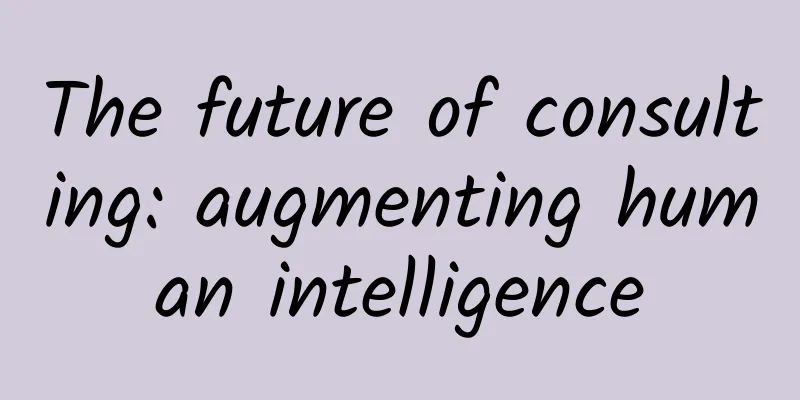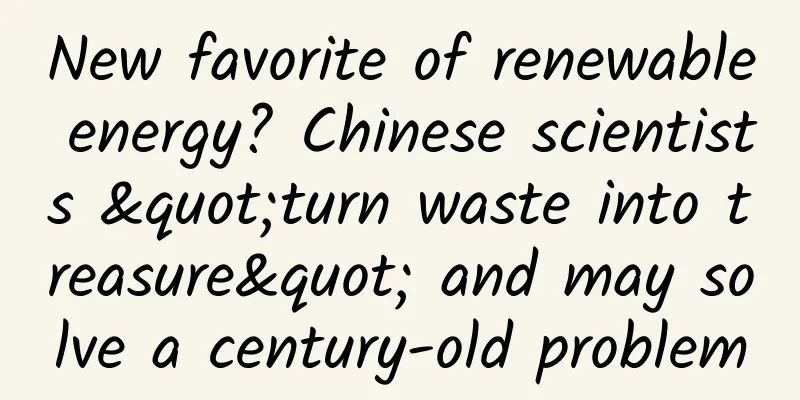The future of consulting: augmenting human intelligence

Individual employees of companies or organizations that rely heavily on the collection, organization and processing of data, information and knowledge are experiencing a major change in their job roles and capabilities. We have begun to move beyond the information age and into an era defined by the efficiency of computing power and new algorithms. From the advancement of quantum computing to the promotion of supercomputing resources, everything indicates that the era of relying on hiring and training "experienced" experts to gain competitiveness is passing, and the future direction is to rely on computing and algorithmic skills and the flexibility of a small number of technicians and engineers to drive significant corporate or organizational value. Traditional approaches to knowledge work and consultingFor many years, organizations have paid high prices to obtain objective consulting advice from experts in order to identify and solve key business problems. However, due to the limited data and information available to consulting teams, as well as the influence of team members' previous experience and expertise, the consulting advice received by organizations is more or less limited. In addition, consultants are often charged by the hour, which results in clients paying high fees for information that is rarely of the value they expected. Cost, time, and the decisions and influence of project sponsors all have an impact on the long-term success of consulting activities. These limitations can seriously hinder the progress of the participating teams, especially when handling client relationships is a major part of the work. This additional work often drives up the total cost of the project, diverts the team's attention from the current work, and often ultimately results in the project's success being largely dependent on the temperament, character, and emotional intelligence of the team members. When conflicts arise, trust may be compromised and some members may leave or be fired, and when a project does not go as expected, the team may look for someone to blame. Similarly, when a team identifies a skills gap, it may try to find short-term fixes or try to bring in more subject matter experts (SMEs). These SMEs need to quickly understand what has been done, where the project is currently going, and where the team is going with the project. This process is challenging and can be costly and time-consuming. Coupled with these costs and complexities, when teams need to solve a critical problem, they often gather in a room for hours or even days to sort through the issues, constraints and options and identify potential paths forward. Towards Augmented Human IntelligenceWhile traditional approaches are sometimes effective, the growing capabilities of cognitive computing systems will increasingly challenge this existing model. Cognitive computing can be described/defined as:
Intelligent clients and algorithm-driven cognitive applications will prove themselves through reduced time to results, higher efficiency, and lower costs. Finally, advanced cognitive computing systems will provide objective strategic guidance with a high level of accuracy and efficiency that is difficult for human teams to achieve. By augmenting human intelligence and maximizing the use of machine intelligence, Thomas Watson's vision mentioned above will begin to be realized. As corporate organizations become more accustomed to using augmented human intelligence and artificial intelligence to solve business problems, they will feel less and less threatened by machines and will welcome them as any valuable team. In a 2014 article published by KMWorld, the authors set out some additional requirements for a powerful cognitive system. These requirements provide a useful framework to help distinguish between advanced systems and AI systems that only have specific capabilities.
Acquire new skills and knowledge – now and in the near futureTop consulting firms shine in their ability to understand complex problems, and they are better able to dig out and clarify the most important challenges faced by users, and use structured problem-solving techniques to guide the project client team in the direction that is best for the organization. Again, this approach is challenging, but with enough people, research, expertise, funding, cooperation, collaboration, influence, change management, leadership, teamwork and persistence, client problems can still be properly identified and solved. The challenges of hiring consultants are often similar to those that organizations face when they ask employees to lead internal change when conducting internal activities. Whether the team resources are composed of organizational employees or consultants, the inefficiencies of teams and the limitations of human cognition always exist. In this case, success often depends on the accumulation of the team, the available funds, the influence of the project leader, the overall priority of the work, and the shared knowledge that the team brings together. When new knowledge or expertise is needed, organizations typically acquire it in three ways: either look for the needed skills internally, contact known experts, or try to hire an employee who has the required knowledge. When the organization does not have the relevant skills in-house and time is critical, a common approach is to hire a consultant who already has the skills and expertise. This is a perfect example of an advanced cognitive system that can be used to provide fact-based, real-time, up-to-date insights and recommendations. Filling knowledge gaps and leveraging cognitive systemsThe questions we need to answer are: How do we limit the amount of human conflict that often influences and drives team dynamics? How do we remove the biases that teams bring to their work? How do we find more efficient ways to acquire expertise and skills? How do we address the issues that drive up management costs and limit the time spent solving problems and creating value? How do we gain useful new knowledge and information to help better understand problems and lead to more objective, accurate and useful recommendations? Finally, what can organizations do to gain world-class expert knowledge that can help provide critical guidance and guidance for strategic decisions, while also delivering planned business value? Accepting cognitive computing will answer these questions. Cognitive computing is a relatively new part of computing, which has gone through the initial tabulation era in the 1940s and the era dominated by programming in the second half of the 20th century. Some industries have begun to accept cognitive computing, and as cognitive computing matures, corporate organizations gradually understand the capabilities and efficiency of this model, and cognitive computing applications in different industries and fields will become more widespread. The secret sauce of cognitive computing is its reliance on machine learning algorithms to transform processed and stored knowledge into actionable insights. These algorithms allow systems to learn and thereby improve and enhance their ability to provide advice (a process that takes very short time periods, measured in minutes or hours). The pattern recognition capabilities to classify and cluster new data and information make these systems extremely valuable. The learning systems also have the ability to integrate new information into a continuous loop of hypothesis generation and scoring, which allows these systems to mimic the practices used in traditional consulting. Develop models for testing and executionMy work in AI and machine learning has led to a growing interest in cognitive computing systems that apply artificial intelligence and augment human intelligence. Data scientists and machine learning researchers are well aware of the potential of these technologies, and they are quickly moving their work from research labs to real-world applications. My approach to learning these topics has been to dive directly into the technical details of the various libraries, languages, and algorithms developed to understand the problem paradigm. However, the real value of this work lies in our ability to stack algorithms, effectively integrate these technologies to produce functional prototypes, and build complex cognitive systems at high speed and efficiency. To fully leverage these technologies, we must understand the basic components of an advanced cognitive system. There are many ways to build such systems, and the rapid pace of innovation in this area is giving rise to new deployment models and implementation frameworks. The following figure lists some of the key processes and components required to build powerful cognitive systems. Although these systems are useful for solving many problems, I focus on their application in augmenting and strengthening knowledge work, especially in strategic decision-making for organizations. To complete such a system, we need to build a system that can provide probabilistic recommendations and strictly deterministic outputs. This important topic even deserves its own article, but a brief description will help us understand the process of generating and delivering insights to business users. I will cover the technical details of this implementation in a subsequent article, but the main purpose of this article is to simply explain its core components at a high level. Because of their importance in processing structured and unstructured data and the important role they play in ensuring that various data types can be extracted and processed, I decided to include some special components in the above figure. From this model, it can be seen that in the knowledge creation stage, machine learning (ML) plays a very important role on both sides of the corpus. Pattern recognition and data preprocessing ensure that machine learning plays a vital role in supporting cognitive computing in the data extraction and predictive specification output stages. Putting cognitive computing into contextFor those who are not familiar with the advancement of AI, think about the neural processes that humans use to decode, store, and recall new information, and you can begin to understand the computational patterns used in these computational models. When humans need to call up information, there are a series of processes in the brain that allow the information to be retrieved and used as needed. Once we built an abstract model of human intelligence, we began to compare it to the computational patterns of human cognition, pattern recognition, classification, and clustering, and found many similarities. My subsequent articles on machine learning (deep neural networks, convolutional deep neural networks, deep belief networks, and recurrent neural networks) and natural language processing will describe these similarities in more detail. The above model can help guide our exploration of cognitive systems. While research in this area has so far focused on the application of specific components in the diagram above, my recent research has focused on the convergence and integration of these components in the delivery of intelligent applications that will redefine what is possible with information and knowledge work. More broadly, investment in and exploration of the application of these technologies will have enormous benefits for solving societal problems and improving the human condition. Cognitive computing systems will be a major enabler as we leverage the power of computing, algorithms, and artificial intelligence to extract, process, store, and derive meaning from data. Using cognitive computing as a core business resource in practiceWith a computer on every employee’s desk and mobile devices becoming a necessity, I suspect that similar waves of adoption will come from smart AI clients and cognitive computing systems. These systems will not be limited to enterprise applications, but will also be available as consumer products, creating a huge market opportunity. However, in the early stages, the technology’s adopters will still be enterprises that expect to reap the huge rewards of seizing the opportunity. As researchers and practitioners continue to develop new applications, industries such as retail and healthcare will continue to produce results, and demand will continue to expand. We have already seen the world’s largest and most powerful digital companies (Facebook, IBM, Google, Baidu, Amazon, Twitter, etc.) invest heavily in cognitive computing, deep learning, and other AI technologies that are considered to be market-ready. As software acquires more human-like perception capabilities and the types and amounts of data it can extract, process, and understand increase, the business cases for investing in and accepting these breakthroughs will surely increase. The more encouraging signs are that tangible business value will not have to wait for 10 or 20 years to be seen. Artificial intelligence will become an important part of your professional life faster than expected, and you will soon be able to enjoy the benefits of artificial intelligence. The interaction between humans and machines will play an increasingly important role in the future of work. From LinkedIn, author Eric Miley, translated by Synced. Translated by Wu Pan. |
>>: Where will Google take us?
Recommend
Apple blocks iOS 16 beta connections, and some websites have been shut down
The iPhone is popular among a large number of us...
Representatives of the 2022 Two Sessions suggested encouraging childbirth through tax means! What specific suggestions do you have? Details attached!
So far, Panzhihua, Sichuan, Beijing, Hunan and ot...
Long article with useful information | This article teaches you how to write popular user cases!
User cases are common promotional materials, and ...
How to use the website imitation tool? How to use the website emulation tool?
For website optimizers, the era of just optimizin...
The cost of acquiring customers is getting higher and higher. How to build a complete user operation system?
How to do user operations ? In fact, most colleag...
China Passenger Car Association & CAM: Passenger car market product competitiveness index is 91.0 in September 2021
The Automobile Market Research Branch of the Chin...
This disease is so painful that it has become a hot topic. Should we get the vaccine that costs thousands of yuan?
recently A pain is a warning sign of shingles Bec...
An article to show you 20 new changes in iOS 12 Beta 5
A few days ago, Apple released the iOS 12 beta 5 ...
[Highly recommended] Four online tracking services to help you identify application anomalies
【51CTO.com Quick Translation】As we all know, soft...
Once a day versus once a week, is washing more often healthier?
Are people who take a shower once a day healthier...
Some plants even want to drink the northwest wind with their roots! What is the secret of aerial roots "drinking water in the air"?
Some plants want to drink the northwest wind even...
Why are hydraulic rods so powerful? Can human power fight against hydraulic arms? A syringe will do
Hydraulic rods are widely used in our lives, from...
Selling 196 million in one day, how did Himalaya achieve growth?
Himalaya was established in 2012. Its previous po...
Will there be a space version of ChatGPT?
ChatGPT is very popular now. As an artificial int...









